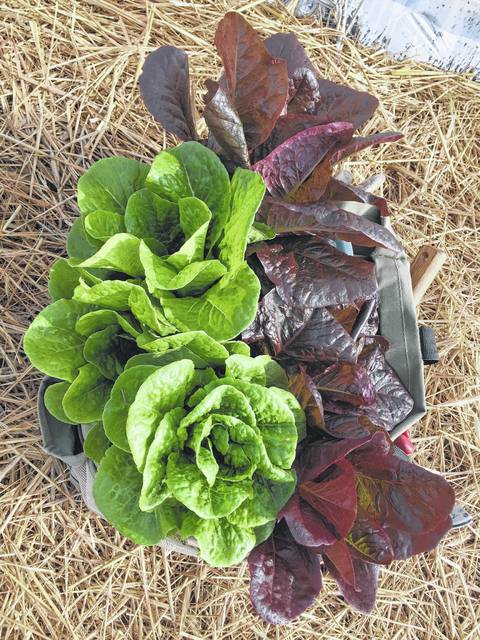Whether I’m buying a bag of mixed lettuce in the grocery store or sitting down to a salad in a restaurant, I’m often disappointed in the quality of the lettuce. At least most restaurants have gotten the message that a salad is more than some chopped iceberg lettuce, but the now-ubiquitous salad of “mixed spring greens” is often tasteless, flaccid and created with lettuce past its prime.
Bagged lettuce from the grocery store may last a couple of days, but all too soon the green slime takes over, and I usually end up throwing it away just a few days after purchasing — and before the sell-by date. At the Sandhills Research Station, we’ve been growing various head lettuce varieties throughout fall and spring, using plastic mulch, drip irrigation, and following organic practices. We’ve been amazed at the taste and quality of the lettuce we’ve grown. Lettuce is surprisingly tough; transplants we had sailed through the March freeze, when temperatures were around 20 degrees with a brutal wind, without so much as a brown leaf (and with no cover at all).
Many home gardeners have mastered “cut-and-come again” mixed-leaf lettuce, which is so easy to grow, but may be intimidated by the idea of growing whole head lettuce. Give it a try! Heads are easy to grow too, and very rewarding.
If planting a fall crop, summer heat will prevent seed germination: seeds basically stop germinating when soil temperatures are above the mid 70s. For a fall crop, plan to pre-germinate the seed and transplant the crop rather than direct seed. Place seeds in the refrigerator for 24-48 hours prior to planting, or even place the transplant trays in a cool basement for 48 hours. After planting, try to keep the soil as cool as possible with mulch (and if you can manage it, a shade cloth at establishment). Using transplants may also help reduce loss to crickets, who love to eat the sweet cotyledon leaves of seedlings.
Lettuce is a heavy feeder, so be sure to amend the soil liberally with compost and fertilize well (include phosphorous in transplant mix to help insure a strong tap root). Lettuce is shallow rooted, so keep weed competition down, but avoid hoeing weeds in a way that could impact crop roots.
Lettuce is a quick crop, between 28 and 55 days, depending on the variety and the season, so take advantage of the (almost) immediate gratification and grow several varieties that appeal to you. There are numerous types to choose from. Start by choosing a variety adapted to the growing season, whether early, mid, or late. There are many varieties to try. The old standby oakleaf Red Salad Bowl and Green Salad Bowl are fine, but try New Red Fire, which makes a large head (it can grow to over 1 pound!) with brilliant burgundy red and lime green coloring. A wonderful bib is the lovely Rosaine, a dark burgundy mini-head lettuce as beautiful as a flower. Green Forest is an excellent romaine that doesn’t get too large.
The beauty of growing your own head lettuce is the incredibly long shelf life — up to three or four weeks with proper handling. The key for retaining quality is proper harvest: pick early in the morning, when temperatures are cooler and the lettuce head is fully hydrated. The white milky sap in lettuce contains latex, which can make the lettuce taste bitter, and harvesting well-hydrated heads helps minimize the problem (plants become less hydrated throughout the day). If your heads should get limp in the fridge, soaking lettuce in cold water can help restore taste and texture.
Now is a great time to plan a lettuce planting that can take your salads and sandwiches through Christmas in a spectacular way, and without the waste of spoiled bagged lettuce. For more information, contact the Extension office at 910-997-8255.
Paige Burns is assistant horticulture agent at the N.C. Cooperative Extension’s Richmond County Center.


